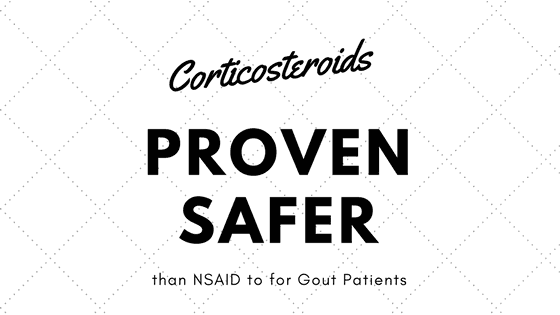For the treatment of inflammation, doctors usually recommend one of two routes: NSAID pain relievers, or corticosteroids. NSAIDs, or non-steroidal anti-inflammatory drugs in their non-acronymic form, encompass standard painkillers like Ibuprofen and Aspirin. Once inside the body, these drugs reduce swelling by blocking the creation of two enzymes integral to the creation of prostaglandins, which cause a swelling/pain reaction to injury. Generally regarded as safe, these drugs have come under scrutiny lately because of their association with gastrointestinal damage and reduced kidney functionality.
By contrast, corticosteroids prevent overactive immune systems from causing more damage to already-compromised tissues by reducing the production of inflammation-inducing chemicals and proteins.
In treating gout, or the gout as it’s called colloquially, doctors go back and forth on whether to prescribe an NSAID pain reliever or a corticosteroid. Gout is a type of arthritis caused by the body’s inhibited ability to metabolize uric acid and is characterized by the swelling and stiffness in fingers and toes, followed by pain in tendons and joints all over the body. As the patients desperately seek a treatment for the inflammation, naturally NSAIDs and corticosteroids are the top two choices. The question remains, though, as to which is not only more effective but also safer.
Studies remain inconclusive as to which is more effective, but a recent paper found that corticosteroids are the safer choice. Encompassing over 800 hospital patients over six trials, the randomized control trial offered half the participants NSAIDs and the other half corticosteroids. Over the course of their seven days, the researchers asked patients about their pain levels and were monitored for the most common side effects of both drugs.
While there was no significant difference between the two groups in terms of reported pain levels both within two days and within seven days, there was a notable difference between them in terms of side effects. Patients on corticosteroids exhibited reduced risk of nausea, vomiting, and indigestion, but higher risks of developing a skin rash than their counterparts taking NSAIDs.
While this study proves promising for determining the safest way to treat patients, the authors admit to a few soft spots in their research. Most glaringly, only about half of the participants in the meta-study could confirm that the participants actually had gout via blood tests demonstrating high levels of uric acid in the blood. The rest only suspected that they were, in fact, suffering from gout. More research is necessary to determine the true best treatment, but this study proved a good preliminary glimpse into the most common reactions to the drugs.

